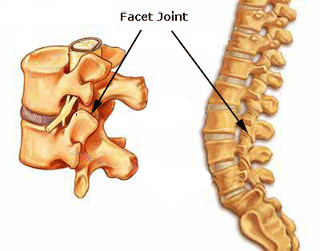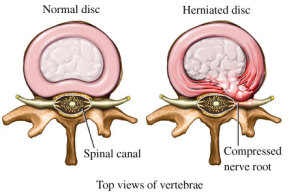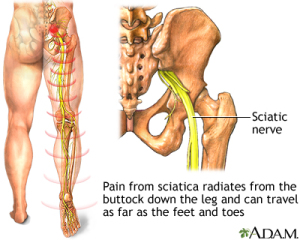Disc Herniation/”Slipped Disc”/Ruptured Disc
A disc herniation occurs when the jelly-like substance from within the intervertebral disc of your spinal column protrudes out the back and side of the spinal column. This protrusion may put pressure on the surrounding nerves or spinal column, causing tingling, pain, and weakness down the affected limb. The intervertebral disc can become dysfunctional because of trauma, the effects of aging, or degenerative disorders of the spine.
Chiropractic:
Research has shown that chiropractic adjustments are more effective than exercises and heat alone in managing intervertebral disc syndrome. Adjustments release painful scar tissue, which relieves pain and restores mobility. Additional tools used to treat disc herniations include interferential current, trigger point therapy, ice, stretches and strengthening exercises.
Acupuncture:
Acupuncture, in conjunction with other treatments, speeds up the healing process, and decreases inflammation. Acupuncture does this by stimulating the natural release of endorphins, which are the body’s natural pain killers. Dr. Rodwin is a certified acupuncturist and will recommend this method of treatment if it is warranted.
Massage Therapy:
A massage therapist’s role in treating disc herniations is to assess posture and focus attention on any muscular imbalances that may be contributing to altered biomechanics. Massage therapy reduces inflammation and can help restore motion to joints and reduce associated muscle spasm.
Low Back Pain
The lower back is a particularly vulnerable area for discomfort, since it supports the entire weight of the upper body. Low back pain can be caused by a variety of factors, including poor posture, pregnancy, stress, compression of nerve roots, bone or joint disease, and many others. This can lead to joint or nerve irritation, disc bulges, and spinal degeneration.
Chiropractic:
Chiropractic adjustments help to relieve muscles spasms, improve nerve supply and blood circulation, and restore motion to the affected joints, relieving any nerve tension and increasing range of motion. Interferential current may be used to reduce pain and inflammation during the early stages. Stretching and strengthening exercises are prescribed to stabilize the low back and prevent recurrence. If muscle adhesions or scar tissue is found in the compensatory muscles, Dr.Rodwin will often use a combination of ART and chiropractic adjustments. This addresses both the joint restrictions and the muscle tightness.
Acupuncture:
Acupuncture, in conjunction with other treatments, speeds up the healing process, and decreases inflammation. Acupuncture does this by stimulating the natural release of endorphins, which are the body’s natural pain killers. Dr. Rodwin is a certified acupuncturist and will recommend this method of treatment if it is warranted.
Massage Therapy:
The aim of massage therapy for this condition is to reduce the tension of the surrounding muscles and soft tissue so that you do not feel as stiff and tight. With the help of a chiropractic adjustment, this also allows the joints not only to return to their original position, but to remain there as well. If muscle adhesions or scar tissue is found in the muscles, the massage therapist may also use ART to break up the scar tissue found.
Facet Irritation or Joint Irritation
Facet irritation refers to inflammation in the joints of the neck (cervical) or back (lumbar).
Chiropractic:
Chiropractic adjustments help restore motion to restricted segments of the spine and reduce inflammation. Soft tissue techniques are used to address surrounding tight musculature.
Acupuncture:
Acupuncture, in conjunction with other treatments, speeds up the healing process, and decreases inflammation. Acupuncture does this by stimulating the natural release of endorphins, which are the body’s natural pain killers. Dr. Rodwin is a certified acupuncturist and will recommend this method of treatment if it is warranted.
Massage Therapy:
Massage therapy will decrease pain and inflammation as well as loosen surrounding musculature. Massage therapy also helps the body hold a chiropractic adjustment by relaxing the muscles.
Sciatica
Sciatic is a term used to describe a symptom rather than a diagnosis. Sciatica refers to inflammation of the sciatic nerve, which runs down the back of the legs and into the feet. Inflammation of this nerve may be caused by a number of sources, including: disc herniations, degeneration, misalignments of the spine, and compression from surrounding tight muscles.
Chiropractic:
Chiropractic treatment addresses all of the possible causes of sciatica. Chiropractic adjustments realign the spinal column and release pressure off the nerve roots of the sciatic nerve, whether it be due to a disc herniation or degeneration. Soft tissue techniques, such as trigger point therapy, are utilized in conjunction with adjustments when there is muscular involvement.
Acupuncture:
Acupuncture, in conjunction with other treatments, speeds up the healing process, and decreases inflammation. Acupuncture does this by stimulating the natural release of endorphins, which are the body’s natural pain killers. Dr. Rodwin is a certified acupuncturist and will recommend this method of treatment if it is warranted.
Massage Therapy:
Massage therapy can relieve compression and pain by reducing muscle tightness. This condition is often related to altered pelvic biomechanics, and specifically, a shortened or stretched iliopsoas muscle. Massage will treat the iliopsoas dysfunction, which will help normalize the function of other muscles in the area. Additionally, massage will ensure normal sacroiliac movement and decrease any related scar tissue.





